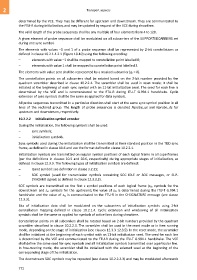Page 782 - 5G Basics - Core Network Aspects
P. 782
2 Transport aspects
determined by the VCE. They may be different for upstream and downstream. They are communicated to
the FTU-R during initialization, and may be updated by request of the VCE during showtime.
The valid length of the probe sequences shall be any multiple of four elements from 4 to 128.
A given element of probe sequence shall be modulated on all subcarriers of the SUPPORTEDCARRIERS set
during one sync symbol.
The elements with values −1 and 1 of a probe sequence shall be represented by 2-bit constellations as
defined in clause 10.2.1.4.2.1 (Figure 10-10) using the following encoding:
– elements with value –1 shall be mapped to constellation point labelled 0;
– elements with value 1 shall be mapped to constellation point labelled 3.
The elements with value zero shall be represented by a masked subcarrier (gi = 0).
The constellation points on all subcarriers shall be rotated based on the 2-bit number provided by the
quadrant scrambler described in clause 10.2.2.4. The scrambler shall be used in reset mode; it shall be
initiated at the beginning of each sync symbol with an 11-bit initialization seed. The seed for each line is
determined by the VCE and is communicated to the FTU-R during ITU-T G.994.1 handshake. Cyclic
extension of sync symbols shall be the same as applied for data symbols.
All probe sequences transmitted in a particular direction shall start at the same sync symbol position in all
lines of the vectored group. The length of probe sequences is denoted Nprobe_us and Nprobe_ds for
upstream and downstream, respectively.
10.2.2.2 Initialization symbol encoder
During the initialization, the following symbols shall be used:
– sync symbols;
– initialization symbols.
Sync symbols used during the initialization shall be transmitted at their standard position in the TDD sync
frame, as defined in clause 10.6 and use the format defined in clause 10.2.2.1.
Initialization symbols are transmitted on regular symbol positions of each logical frame in all superframes
(per the definitions in clauses 10.5 and 10.6, respectively) during appropriate stages of initialization, as
defined in clause 12.3.3. The following types of initialization symbols are defined:
– Quiet symbol: see definition in clause 3.2.25;
– SOC symbol (used for transmission symbols containing SOC IDLE or SOC messages, or O-P-
SYNCHRO signals as defined in clause 12.3.3.3).
SOC symbols are transmitted on the first s symbol positions of each logical frame (sds symbols for the
downstream and sus symbols for the upstream); the value of sds is determined during the ITU-T G.994.1
handshake and the value of sus is communicated to the FTU-R in the O-SIGNATURE message (see clause
12.3.3).
Bits of initialization data shall be modulated on the subcarriers of initialization symbols using 2-bit
constellation mapping defined in clause 10.2.1.4. Cyclic extension and windowing of all initialization
symbols shall be the same as applied for symbols of active lines during showtime.
Constellation points on all subcarriers shall be rotated based on 2-bit numbers provided by the quadrant
scrambler described in clause 10.2.2.4. The scrambler shall be used in the reset mode or in free running
mode, depending on the stage of initialization (see clauses 12.3.3-12.3.5). In the reset mode, the scrambler
shall be initialized at the beginning of each symbol with an 11-bit initialization seed. The seed for each line
is determined by the VCE and communicated to the FTU-R during the ITU-T G.994.1 handshake. The VCE
shall define the same seed for sync symbols and all initialization symbols transmitted over a particular line.
In free-running mode, the scrambler shall be initialized with the selected seed at the beginning of the
corresponding stage of the initialization.
The downstream SOC symbols may be repeated (see clause 10.2.2.2.3) and may be modulated afterwards
772

